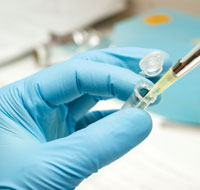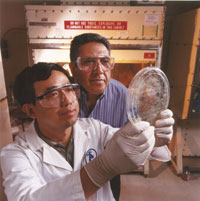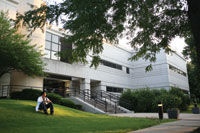Even in today’s globally connected marketplace, where you locate or expand your business can be a major factor in determining your long-term success. Illinois’ diversity is its strength. No state matches Illinois’ breadth of rich offerings in medical, agricultural, industrial biotechnology, and nanotechnology. Illinois provides resources to support every stage and area of innovative technology development, from basic research start-ups to large corporations. The state’s commitment to collaboration is unparalleled, as evidenced by flourishing public, private and academic partnerships throughout the state.
But there’s more. Along with a $590 billion economy – the nation’s fifth largest – Illinois boasts a six million-strong workforce. Illinois is home to 33 Fortune 500 companies; the world’s largest futures and options exchange, CME Group Inc.; and is the national crossroads for rail, auto, truck and air. Many companies choose Illinois because of its talented workforce, easy access to key markets and positive business climate.
Biotechnology Illinois is a biotechnology hotbed because of an unmatched combination of Chicago’s bustling, big-city economy and the state’s vast productive agricultural community. In 2006 the prestigious BIO International Convention was held in Chicago for the first time. Based on the convention’s tremendous success, it will return to Chicago in 2010.
Illinois is a biotechnology hotbed because of an unmatched combination of Chicago’s bustling, big-city economy and the state’s vast productive agricultural community. In 2006 the prestigious BIO International Convention was held in Chicago for the first time. Based on the convention’s tremendous success, it will return to Chicago in 2010.
Illinois is home to a growing number of healthcare companies, ranging from early-stage drug discovery companies to diversified global corporations. Illinois companies are developing breakthroughs in vaccines, diagnostics, cell therapies, drug delivery systems, cancer therapies and a wide range of other treatments for human diseases. Some of the national and international industry leaders are based in Illinois, including Abbott, Archer Daniels Midland, Astellas U.S., LLC, Baxter International, Hospira, Siemens Medical Solutions Diagnostics, and Takeda Pharmaceuticals North America.
When people connect Illinois with biotechnology, some think of agriculture first. That’s quite natural, since Illinois is a world leader in agricultural research and production. Agricultural scientists in the public and private sectors are working together to develop crops that reduce the use of chemical pesticides, boost the nutritional value of the world’s food supply, enable farmers to grow more food on less land, tap into the potential of biofuels and protect the environment.
Because of its location, Illinois has long been one of the world’s major food processing hubs. Innovative agricultural companies that are using Illinois operations to improve plant and agricultural practices and enhance industrial product development include John Deere, Cargill, Monsanto, Caterpillar, Pioneer, Renessen, Tate & Lyle among many others.
Illinois is also one of the nation's largest ethanol producers, and is working hard to maintain leadership in biofuels technology development and production. When BP decided to create a $500 million energy research program in 2007, it tapped the University of Illinois at Urbana-Champaign (UIUC) as one of its partners for its new Energy BioSciences Institute (EBI). UIUC researchers will explore how adequate supplies of high-quality plant biomass (e.g., corn crop residues, switchgrass, Miscanthus, and other herbaceous perennials) can be sustainably produced and utilized in facilities that convert the biomass to fuels.
Nanotechnology
Illinois is widely considered one of the world’s most advanced centers of nanotechnology. Its combination of research institutions and public and private companies make Illinois a recognized leader in this important field of science and technology.
 The International Institute for Nanotechnology (IIN) is an innovative and far-reaching collaborative venture between Northwestern University, Argonne National Laboratory’s Center for Nanoscale Materials and their partners. The IIN is anchored by major research centers at Northwestern, including the Nanoscale Science & Engineering Center, the Center for Cancer Nanotechnology, the Center for Nanofabrication and Molecular Self-Assembly, and more. Technologies developed at the IIN have been commercialized and are being used by researchers worldwide. In addition, the IIN already has spawned 15 start-up companies.
The International Institute for Nanotechnology (IIN) is an innovative and far-reaching collaborative venture between Northwestern University, Argonne National Laboratory’s Center for Nanoscale Materials and their partners. The IIN is anchored by major research centers at Northwestern, including the Nanoscale Science & Engineering Center, the Center for Cancer Nanotechnology, the Center for Nanofabrication and Molecular Self-Assembly, and more. Technologies developed at the IIN have been commercialized and are being used by researchers worldwide. In addition, the IIN already has spawned 15 start-up companies.
Other important research centers include the University of Illinois at Urbana-Champaign’s Micro and Nanotechnology Laboratory, and Argonne National Laboratory’s Center for Nanoscale Materials.
Illinois’ global leadership position in nanotechnology is built in part on the diversity of the state’s research and commercial applications for nanotech products in medicine, agriculture and information technology.
Premier R&D Facilities
With more than 200 academic, government and non-profit research institutions, Illinois has one of the largest concentrations of research in the world. Illinois has invested heavily in its technological infrastructure. For example, a rich array of office and wet lab facilities, incubators and technology parks are available throughout the state. Equally impressive is the range and quality of research that emerges from Illinois each year.
Argonne National Laboratory is one of the U.S. Department of Energy’s largest research centers. Through its collaboration with the University of Chicago, Argonne and the university are a $750 million research engine that brings together more than 25,000 scientists, engineers, staff and students in the study of materials science, chemistry, biology, high-energy physics, high-performance computing and more. Argonne’s $20 billion Advanced Photon Source is a powerful tool for the study of proteomics. Research and commercialization initiatives are enhanced by the Terascale Computing System (TeraGrid), a collaboration with the University of Illinois at Urbana-Champaign. TeraGrid is the world’s largest, most comprehensive distributed cyber-infrastructure for open scientific research.
 Fermi National Accelerator Laboratory builds and operates the accelerators, detectors and other facilities that physicists need to conduct research in high-energy physics. Fermilab is the largest high-energy physics laboratory in the United States and the second largest in the world.
Fermi National Accelerator Laboratory builds and operates the accelerators, detectors and other facilities that physicists need to conduct research in high-energy physics. Fermilab is the largest high-energy physics laboratory in the United States and the second largest in the world.
The National Center for Agricultural Utilization Research (NCAUR) in Peoria is the largest of four USDA federal utilization centers and a world-class bioscience center. NCAUR invents new industrial and food products from agricultural commodities, develops new technology to improve environmental quality and provides technical support to federal regulatory and action agencies.
The University of Illinois, with campuses in Chicago, Springfield and Urbana-Champaign, is developing breakthroughs in many fields of science and technology. The university spends more than $800 million annually in research, placing it among the nation’s top engines of innovation. The Institute for Genomic Biology (IGB) conducts transformative research in agriculture, human health, the environment, and energy use and production. The university is also well-known for its National Center for Supercomputing Applications (NCSA) program and its Center for Advanced BioEnergy Research (CABER).
Research thrives at Northwestern University, with an annual budget of over $1.5 billion and more than $416 million in sponsored research. At Northwestern, interdisciplinary teams work closely with experts at Argonne National Laboratory, Fermilab and other Illinois universities. More than 110 centers support interdisciplinary research on Northwestern’s two lakeshore campuses, ranging from materials science to biomedical engineering to marketing new technologies.
Breakthrough science and technology discoveries emerge from other Illinois academic centers of excellence, including the University of Chicago, Rush University Medical Center, the Illinois Institute of Technology and Southern Illinois University, among many others.
Through these collaborative efforts Illinois is strengthening its position as a major research hub and creating an environment where innovation can continue to flourish.
